初中英语介词练习题及答案
- 格式:pdf
- 大小:138.09 KB
- 文档页数:5
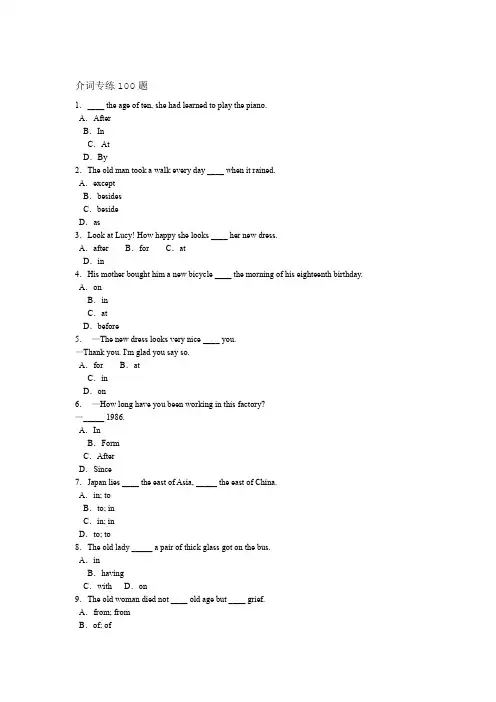
介词专练100题1.____ the age of ten, she had learned to play the piano.A.AfterB.InC.AtD.By2.The old man took a walk every day ____ when it rained.A.exceptB.besidesC.besideD.as3.Look at Lucy! How happy she looks ____ her new dress.A.after B.for C.atD.in4.His mother bought him a new bicycle ____ the morning of his eighteenth birthday. A.onB.inC.atD.before5.—The new dress looks very nice ____ you.—Thank you. I'm glad you say so.A.for B.atC.inD.on6.—How long have you been working in this factory?—_____ 1986.A.InB.FormC.AfterD.Since7.Japan lies ____ the east of Asia, _____ the east of China.A.in; toB.to; inC.in; inD.to; to8.The old lady _____ a pair of thick glass got on the bus.A.inB.havingC.with D.on9.The old woman died not ____ old age but ____ grief.A.from; fromB.of; ofC.of; from D.from; of10.He can speak two other foreign language well ____ English.A.exceptB.besidesC.besideD.except for11.Your composition is excellent, ____ some spelling mistakes.A.exceptB.besidesC.except forD.beside12.The young man was given a medal _____ what he had achieved in his research work. A.sinceB.because of C.because D.as13.Last summer we visited ____ beautiful places ____ Hangzhou, Huangshan and Nanjing. A.so; as B.such; like C.not as; as D.such; asI met Jim ____ the first time when I was in Harry's..14.A.at B.in C.for D.of15.Went for a walk in the forest ____ the moonlight.A.onB.inC.for D.by16.Which subject are you good ____, English or maths?A.onB.inC.ofD.at17.Did you see a girl ____ golden hair walk into the room?A.with B.ofC.has D.in18.____ the opinion of most people it is not good to eat too much meat.A.InB.For C.ToD.On19.It is the best answer ____ the question.A.ofB.about C.for D.to20.They found nothing ___ a stone in the parcel.A.besideB.but C.besidesD.like21.The fish with sharp teeth can eat a person ____ two minutes.A.after B.atC.for D.in22.____ the afternoon of June 18, we'll visit the school.A.InB.AtC.On D.By23.Some food and clothing will be supplied ____ the poor people in the mountain areas. A.for B.toC.atD.with24.He spent a large part of his salary _____ books.A.inB.onC.for D.at25.Sorry, I don't agree ____ your plan.A.toB.onC.about D.with26.There will be a party ____ New Year's Eve.A.onB.atC.for D.from27.I've been here ____ the year 1995.A.ever beforeB.ever sinceC.inD.during28.The Yellow River is the longest river ____ to the Changjiang River.A.next B.than C.toD.forGrapes can be made ____ wine..—29.—Is this bottle of wine made ____ grapes, too?—Sure. And it is made ____ China.A.into, of, for B.into, from, inDof, from, in.from, into, byC.30._____ my visit to Europe, I finally arrived ____ Italy.A.On, inB.On, atC.During, inD.In, at31.The doctor will be free ____ .A.10 minutes later B.after 10 minutesD .10 minutes afterC.in 10 minutes32.They will try their best to compete ___ a race ____ a prize.A.for, forB.in, forC.with, inD.in, in33.It doesn't seem useful ____ them to go on with the work.A.ofB.for C.toD.by34.It's really nice ____ you to come and see me.A.ofB.for C.toD.from35.The door closed ____ itself.A.for B.ofC.toD.in36.It was careless ____ him to drop his watch into the river.A.toB.with C.for D.of37.Since I came to China I've known that about seven people ____ ten speak Putonghua. A.ofB.toC.inD.about38.____ last month, Jack had been late for three times.A.By B.Since C.InD.For39.Let's walk over ____ the sun ____ the other side of the street.A.in, toB.to, on C.under, to D.by, at40.They went to school by bike ____ foot today.A.but B.instead of on C.but onD.instead of41.I knew nothing about the accident ____ what I read in the paper.A.but B.instead of on C.but onD.instead ofIt is not always east to tell right ____ wrong..42.A.or B.between C.and D.from43.We walked ____ Tian An Men square to the Monument ____ the People's Heroes. A.across, to B.across, of C.through, forD.past, to44.The boat is passing ____ the bridge.A.underB.through C.acrossD.towards45.They will leave a week ____ today. I do hope they can finish the work.A.fromB.onC.byD.for46.We need fifteen more people ____ our team to do the job.A.but B.exceptC.as wellD.besides47.I couldn't sleep well ____ all the windows open.A.when B.with C.for D.because of48.I recognized the handwriting _____.A.as our monitor B.like our monitorD.like that of my monitorC .as that of our monitor's49.Sports and games can be ____ great help to us. Let's all do more sports.A.ofB.with C.for D.in50.____ the two stories I've just read, I like the one written by the young lady better. A.InB.By C.OfD.From51.We planned to get to London ____ Monday, but I didn't arrive ____ Friday. A.on, onB.till, onC.to, from D.on, until52.The accident happened ____ a cold winter morning.A.inB.onC.for D.by53.About twenty percent of the population of our country live ____ wages.A.byB.onC.with D.in54.Your voice sounds different ____ the phone.A.inB.for C.from D.on55.The house is ____ fire; call ____ help quickly, or break the glass to sound the alarm. A.on, forB.at, forC.in, to D.on, to56.A new bridge will be built ____ the river.through.D over .C in.B by.A.57.Our National Flag stands out brightly ____ the blue sky.A.againstB.byC.under D.over58.Eating too much sweets and chocolates _____ meals is bad for you.A.amongB.through C.between D.for59.She looks quite young ____ her age.A.for B.ofC.inD.about60.I hope you can answer the paper ____ ink, not ____ pencil.A.at, withB.with, in a C.in, with a D.with, in61.The small village lies ____ the west of the river.A.atB.inC.from D.to62.The children are really hungry now, so we'd better find a restaurant to eat ____.A.atB.for C./ D.with63.The manager walked ____ the room, not knowing what to do with the workers. A.back and forth B.to and fromDup and down .backwards and forwardsC.64.Shall we make it a rule that no language ____ English should be spoken in an English Class.A.but B.besidesC.unlessD.like65.It is rude to make fun ____ the disabled.A.atB.about C.ofD.with66._____ the bad weather, we would have gone picnicking yesterday.A.In spite ofB.But forC.Because ofD.As for67.It's very kind ____ to help us ____ the harvest.A.of you; in B.for them; with C.of them; with D.for you; in68.They look _____ the way as the key _____ success.A.for; ofB.through; forC.on; to D.at; with69.It seems that he is always ____.A.in hurry B.in a hurry C.with a hurryD.with hurryGrapes are made ____ wine. That is to say, wine is made _____ grapes..70.A.of, into B.into, of C.from, from D.into, from71.The old couple went out for a walk every morning ____ when it rained.A.besidesB.except forC.exceptD.except that72.They used to live ____ 101 Heping Road, Tianjin.A.onB.atC.toD.of73.Can you imagine how excited my grandma was the first time she talked to me ____ telephone?A.onB.byC.over D.through74.Pop singers both at home and abroad are very popular ____ young people.A.byB.toC.with D.for75.—Why were you absent ____ school yesterday?—I was ill ____ bed.A.from, in B.to, on C.at, inD.in, on76.He introduced himself ____ Big John, but his real name is John Williams.A.toB.like C.asD.for77.As a housekeeper, ____ working, washing and sewing, she had to take care of four small Children.A.besideB.exceptC.except forD.besides78.____ everyone's surprise, the seven-year-old boy worked out the problem ____ no difficulty.A.To, with B.In, with C.To, in D.For, in79.The old men was ____ help, he is dying.A.without B.besideC.beyondD.against80.We offered him our congratulations ____ his achievements.A.atB.onC.for D.of81.It was a story ____ slum life(贫民窟)in Chicago.A.inB.about C.from D.of82.A steamer was going along ____ full speed, when it suddenly got into shallow water and ran aground.by.D with .C on.B at.A.83.John bought an expensive walkman ____ the money his father had given him.A.with B.byC.inD.through84.I knew nothing about it ____ he told me the other day.A.exceptB.except forC.except whatD.besides that85.The teacher together with ____ is going to see the film.A.usB.we C.our D.they86.Many new houses and tall buildings have been set up for teachers and it ____ an improvement of their conditions.A.has brought about B.has brought upD .C.has brought around has brought for87.In the march ____ the blazing (炙热)sands they experienced hunger, thirst and heat. A.through B.past C.crossD.across88.The bus stop is just across the street. It means ____.A.The bus stop is just on the other side of the street.B.The bus stop is just on the opposite side of the street.C.If you want to get to the bus stop, you must walk across the street.D.the bus stop is over there when you walk straight along the street.89.With her brown hair and blue eyes Jane seems to ____ her mother but in other ways she is more like her father.A.look after B.take after C.run after D.be after90.Not only did they plant many trees but also they took measures ____ tree diseases. A.for B.againstC.through D.to91.Some people became passive(not active) and stop working whenever anything ____ their wishes or wills.A.is against B.runs againstC.goes againstD.is for92.Ah. Margaret, come ____, the fruit shop is quite near. Just ____ the corner. A.along, behind B.across, around C.with, acrossD.along, around93.Try to be clam and sensitive ____ of danger.A.at the moment B.of the moment C.in the moment D.on the moment____ o the term, our form-teacher addressed us in an excellent speech. He impressed us a .94.lot.A.At the beginningB.In the beginningC.In the endD.At the middle95.He has a good head ____.A.by businessB.in businessC.for businessD.on business96.It happened to be very cold ____ the morning of our sports meet.A.atB.ofC.onD.with97.The table belongs ____ the corner.A.toB.inC.with D.on98.Tom was gentle and he often talked with others ____ a low voice but this time he shouted suddenly ____ the top of his voice.A.in, atB.at, inC.at, withD.in, with99.The policeman angrily seize the man ____ the collar, and asked him what he meant bysuch bad behaviour.A.byB.inC.with D.at100.They themselves take their work for granted, and do not care what strangers may think____ it.A.atB.about C.inD.with答案:1-5CADAD 6-10DACBB 11-15CBDCB 16-20 DAADB 21-25 DCBBA 26-30 ABABA 31-35 CBBAB 36-40 DCABB 41-45 CDAAA 46-50 ABACA 51-55 DBBDA 56-60 CACAC 61-65 DACAC 66-70 BCCBD 71-75 CBBCA 76-80 CDACB 81-85 BAACA 86-90 ADABB 91-95 ABCAC 96-100 C DAAB。
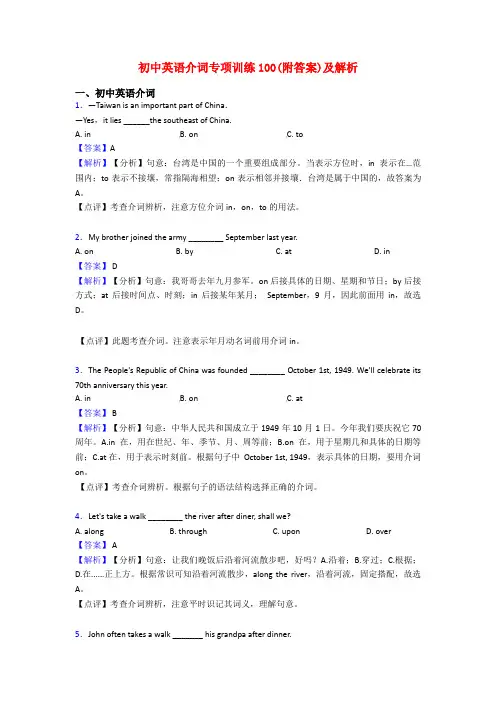
初中英语介词专项训练100(附答案)及解析一、初中英语介词1.—Taiwan is an important part of China.—Yes,it lies ______the southeast of China.A. inB. onC. to【答案】A【解析】【分析】句意:台湾是中国的一个重要组成部分。
当表示方位时,in表示在…范围内;to表示不接壤,常指隔海相望;on表示相邻并接壤.台湾是属于中国的,故答案为A。
【点评】考查介词辨析,注意方位介词in,on,to的用法。
2.My brother joined the army ________ September last year.A. onB. byC. atD. in【答案】 D【解析】【分析】句意:我哥哥去年九月参军。
on后接具体的日期、星期和节日;by后接方式;at后接时间点、时刻;in后接某年某月;September,9月,因此前面用in,故选D。
【点评】此题考查介词。
注意表示年月动名词前用介词in。
3.The People's Republic of China was founded ________ October 1st, 1949. We'll celebrate its 70th anniversary this year.A. inB. onC. at【答案】 B【解析】【分析】句意:中华人民共和国成立于1949年10月1日。
今年我们要庆祝它70周年。
A.in在,用在世纪、年、季节、月、周等前;B.on在,用于星期几和具体的日期等前;C.at在,用于表示时刻前。
根据句子中 October 1st, 1949,表示具体的日期,要用介词on。
【点评】考查介词辨析。
根据句子的语法结构选择正确的介词。
4.Let's take a walk ________ the river after diner, shall we?A. alongB. throughC. uponD. over【答案】 A【解析】【分析】句意:让我们晚饭后沿着河流散步吧,好吗?A.沿着;B.穿过;C.根据;D.在......正上方。
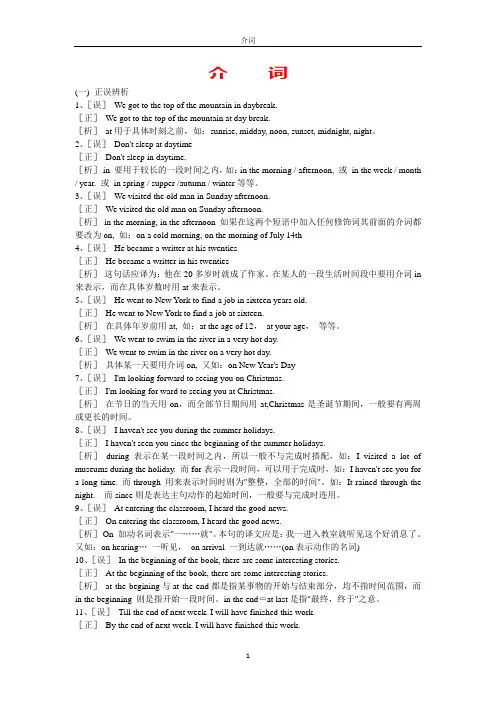
介词(一) 正误辨析1、[误]We got to the top of the mountain in daybreak.[正]We got to the top of the mountain at day break.[析]at用于具体时刻之前,如:sunrise, midday, noon, sunset, midnight, night。
2、[误]Don't sleep at daytime[正]Don't sleep in daytime.[析]in 要用于较长的一段时间之内,如:in the morning / afternoon, 或in the week / month / year. 或in spring / supper /autumn / winter等等。
3、[误]We visited the old man in Sunday afternoon.[正]We visited the old man on Sunday afternoon.[析]in the morning, in the afternoon 如果在这两个短语中加入任何修饰词其前面的介词都要改为on, 如:on a cold morning, on the morning of July 14th4、[误]He became a writter at his twenties[正]He became a writter in his twenties[析]这句话应译为:他在20多岁时就成了作家。
在某人的一段生活时间段中要用介词in 来表示,而在具体岁数时用at来表示。
5、[误]He went to New Y ork to find a job in sixteen years old.[正]He went to New Y ork to find a job at sixteen.[析]在具体年岁前用at, 如:at the age of 12,at your age,等等。
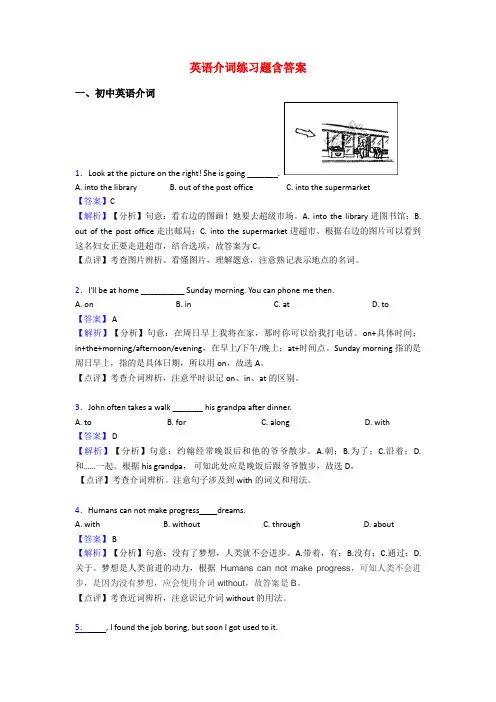
英语介词练习题含答案一、初中英语介词1.Look at the picture on the right! She is going _______.A. into the libraryB. out of the post officeC. into the supermarket【答案】C【解析】【分析】句意:看右边的图画!她要去超级市场。
A. into the library进图书馆;B. out of the post office走出邮局;C. into the supermarket进超市。
根据右边的图片可以看到这名妇女正要走进超市,结合选项,故答案为C。
【点评】考查图片辨析。
看懂图片,理解题意,注意熟记表示地点的名词。
2.I'll be at home __________ Sunday morning. You can phone me then.A. onB. inC. atD. to【答案】 A【解析】【分析】句意:在周日早上我将在家,那时你可以给我打电话。
on+具体时间;in+the+morning/afternoon/evening,在早上/下午/晚上;at+时间点。
Sunday morning指的是周日早上,指的是具体日期,所以用on,故选A。
【点评】考查介词辨析,注意平时识记on、in、at的区别。
3.John often takes a walk _______ his grandpa after dinner.A. toB. forC. alongD. with【答案】 D【解析】【分析】句意:约翰经常晚饭后和他的爷爷散步。
A.朝;B.为了;C.沿着;D.和……一起。
根据his grandpa,可知此处应是晚饭后跟爷爷散步,故选D。
【点评】考查介词辨析。
注意句子涉及到with的词义和用法。
4.Humans can not make progress dreams.A. withB. withoutC. throughD. about【答案】 B【解析】【分析】句意:没有了梦想,人类就不会进步。
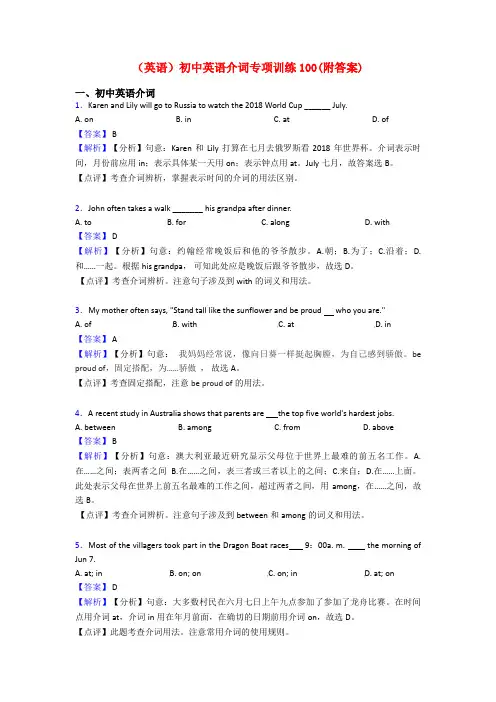
(英语)初中英语介词专项训练100(附答案)一、初中英语介词1.Karen and Lily will go to Russia to watch the 2018 World Cup ______ July.A. onB. inC. atD. of【答案】 B【解析】【分析】句意:Karen和Lily打算在七月去俄罗斯看2018年世界杯。
介词表示时间,月份前应用in;表示具体某一天用on;表示钟点用at。
July七月,故答案选B。
【点评】考查介词辨析,掌握表示时间的介词的用法区别。
2.John often takes a walk _______ his grandpa after dinner.A. toB. forC. alongD. with【答案】 D【解析】【分析】句意:约翰经常晚饭后和他的爷爷散步。
A.朝;B.为了;C.沿着;D.和……一起。
根据his grandpa,可知此处应是晚饭后跟爷爷散步,故选D。
【点评】考查介词辨析。
注意句子涉及到with的词义和用法。
3.My mother often says, "Stand tall like the sunflower and be proud who you are." A. of B. with C. at D. in【答案】 A【解析】【分析】句意:我妈妈经常说,像向日葵一样挺起胸膛,为自己感到骄傲。
be proud of,固定搭配,为……骄傲,故选A。
【点评】考查固定搭配,注意be proud of的用法。
4.A recent study in Australia shows that parents are the top five world's hardest jobs.A. betweenB. amongC. fromD. above【答案】 B【解析】【分析】句意:澳大利亚最近研究显示父母位于世界上最难的前五名工作。
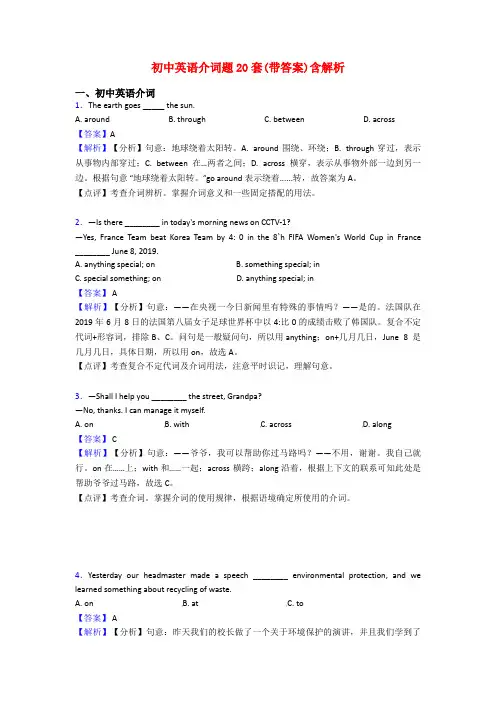
初中英语介词题20套(带答案)含解析一、初中英语介词1.The earth goes _____ the sun.A. aroundB. throughC. betweenD. across【答案】A【解析】【分析】句意:地球绕着太阳转。
A. around围绕、环绕;B. through穿过,表示从事物内部穿过;C. between在…两者之间;D. across横穿,表示从事物外部一边到另一边。
根据句意“地球绕着太阳转。
”go around表示绕着......转,故答案为A。
【点评】考查介词辨析。
掌握介词意义和一些固定搭配的用法。
2.—Is there ________ in today's morning news on CCTV-1?—Yes, France Team beat Korea Team by 4: 0 in the 8`h FIFA Women's World Cup in France ________ June 8, 2019.A. anything special; onB. something special; inC. special something; onD. anything special; in【答案】 A【解析】【分析】句意:——在央视一今日新闻里有特殊的事情吗?——是的。
法国队在2019年6月8日的法国第八届女子足球世界杯中以4:比0的成绩击败了韩国队。
复合不定代词+形容词,排除B、C。
问句是一般疑问句,所以用anything;on+几月几日,June 8 是几月几日,具体日期,所以用on,故选A。
【点评】考查复合不定代词及介词用法,注意平时识记,理解句意。
3.—Shall I help you ________ the street, Grandpa?—No, thanks. I can manage it myself.A. onB. withC. acrossD. along【答案】 C【解析】【分析】句意:——爷爷,我可以帮助你过马路吗?——不用,谢谢。

.介词专练 100 题1. ____ the age of ten, she had learned to play the piano.A. After B. In C. At D. By 2. The old man took a walk every day ____ when it rained.A. except B. besides C. beside D.as 3. Look at Lucy! How happy she looks ____ her new dress.A. after B. for C. at D. in 4. His mother bought him a new bicycle ____ the morning of his eighteenth birthday.A. on B. in C. at D.before 5.—The new dress looks very nice ____ you.—Thank you. I ’m glad you say so.A. for B. at C. in D.on 6.—How long have you been working in this factory?—_____ 1986.A. In B. Form C. After D. Since 7. Japan lies ____ the east of Asia, _____ the east of China.A. in; to B. to; in C.in; inD. to; to8. The old lady _____ a pair of thick glass got on the bus.A. in B. having C. with D.on 9. The old woman died not ____ old age but ____ grief.A. from; from B. of; of C. of; from D. from; of 10. He can speak two other foreign language well ____ English.A. except B. besides C. beside D.except for 11. Your composition is excellent, ____ some spelling mistakes.A. except B. besides C. except for D. beside 12. The young man was given a medal _____ what he had achieved in his research work.A. since B. because of C.because D.as13. Last summer we visited ____ beautiful places ____ Hangzhou, Huangshan and Nanjing.A. so; as B. such; like C.not as; as D. such; as14. I met Jim ____ the first time when I was in Harry’s.A. at B. in C. for D.of 15. Went for a walk in the forest ____ the moonlight.A. on B. in C. for D.by 16. Which subject are you good ____, English or maths?A. on B. in C. of D.at 17. Did you see a girl ____ golden hair walk into the room?A. with B. of C. has D.in 18. ____ the opinion of most people it is not good to eat too much meat.A. In B. For C. To D.On 19. It is the best answer ____ the question.A. of B. about C. for D. to 20. They found nothing ___ a stone in the parcel.A. beside B. but C. besides D.like 21. The fish with sharp teeth can eat a person ____ two minutes.A. after B. at C. for D. in 22. ____ the afternoon of June 18, we’ll visit the school.A. In B. At C. On D.By 23. Somefood and clothing will be supplied ____ the poor people in the mountain areas.A. for B. to C. at D.with 24. He spent a large part of his salary _____ books.A. in B. on C. for D.at 25. Sorry, I don’tagree ____ your plan.A. to B. on C. about D. with 26. There will be a party ____ New Year’s Eve.A. on B. at C. for D.from 27. I ’ve been here ____ the year 1995.A. ever before B. ever since C. in D. during 28. The Yellow River is the longest river ____ to the Changjiang River.A. next B. than C. to D.for 29.— Grapes can be made ____ wine.—Is this bottle of wine made ____ grapes, too?—Sure. And it is made ____ China.A. into, of, for B. into, from, inC. of, from, in D. from, into, by 30. _____ my visit to Europe, I finally arrived ____ Italy.A. On, in B. On, at C. During, in D. In, at 31. The doctor will be free ____ .A. 10 minutes later B. after 10 minutesC. in 10 minutes D. 10 minutes after 32. They will try their best to compete ___ a race ____ a prize.A. for, for B. in, for C. with, in D.in, in 33. It doesn ’tseem useful ____ them to go on with the work.A. of B. for C. to D.by 34. It ’s really nice ____ you to come and see me.A. of B. for C. to D.from 35. The door closed ____ itself.A. for B. of C. to D.in 36. It was careless ____ him to drop his watch into the river.A. to B. with C. for D.of 37. Since I came to China I’ve known that about seven people ____ ten speak Putonghua.A. of B. to C. in D.about 38. ____ last month, Jack had been late for three times.A. By B. Since C. In D. For39. Let ’s walk over ____ the sun ____ the other side of the street.A. in, to B. to, on C.under, toD. by, at40. They went to school by bike ____ foot today.A. but B. instead of on C. but on D . instead of41. I knew nothing about the accident ____ what I read in the paper.A. but B. instead of on C. but on D . instead of42. It is not always east to tell right ____ wrong.A. or B. between C. and D.from 43. Wewalked ____ Tian An Men square to the Monument ____ the People ’s Heroes.A. across, to B. across, of C.through, for D.past, to44. The boat is passing ____ the bridge.A. under B. through C. across D. towards 45. They will leave a week ____ today. I do hope they can finish the work.A. from B. on C. by D.for 46. We need fifteen more people ____ our team to do the job.A. but B. except C. as well D.besides 47. I couldn’tsleep well ____ all the windows open.A. when B. with C. for D.because of 48. I recognized the handwriting _____.A. as our monitor B. like our monitorC. as that of our monitor’s D. like that of my monitor 49. Sports and games can be ____ great help to us. Let’s all do more sports.A. of B. with C. for D.in 50. ____ the two stories I’ve just read, I like the one written by the younglady better.A. In B. By C. Of D.From51. We planned to get to London ____ Monday, but I didn’tarrive ____ Friday.A. on, on B. till, on C. to, from D.on, until 52. The accident happened ____ a cold winter morning.A. in B. on C. for D.by 53. About twenty percent of the population of our country live ____ wages.A. by B. on C. with D.in 54. Your voice sounds different ____ the phone.A. in B. for C. from D.on 55. The house is____ fire;call____ help quickly, or break the glass to sound the alarm.A. on, for B. at, for C. in, to D.on, to 56. A new bridge will be built ____ the river.A. by B. in C. over D.through 57. Our National Flag stands out brightly ____ the blue sky.A. against B. by C. under D. over 58. Eating too much sweets and chocolates _____ meals is bad for you.A. among B. through C. between D.for 59. She looks quite young ____ her age.A. for B. of C. in D.about 60. I hope you can answer the paper ____ ink, not ____ pencil.A. at, with B. with, in a C. in, with a D.with, in61 . The small village lies ____ the west of the river.A. at B. in C. from D.to 62. The children are really hungry now, so we’d better find a restaurant to eat ____.A. at B. for C. /D. with 63. The manager walked ____ the room, not knowing what to do with the workers.A. back and forth B. to and fromC. up and down D. backwards and forwards64. Shall we make it a rule that no language ____ English should be spoken in an English Class.A. but B. besides C. unless D.like 65. It is rude to make fun ____ the disabled.A. at B. about C. of D. with 66. _____ the bad weather, we would have gone picnicking yesterday.A. In spite of B. But for C. Because of D. As for 67. It ’s very kind ____ to help us ____ the harvest.A. of you; in B. for them; with C.of them;withD. for you; in68. They look _____ the way as the key _____ success.A. for; of B. through; for C. on; to D. at; with 69. It seems that he is always ____.A. in hurry B. in a hurry C. with a hurry D.with hurry70. Grapes are made ____ wine. That is to say, wine is made _____ grapes.A. of, into B. into, of C. from, from D.into, from 71. The old couple went out for a walk every morning ____ when it rained.A. besides B. except for C. except D . except that72. They used to live ____ 101 Heping Road, Tianjin.A. on B. at C. to D.of73. Can you imagine how excited my grandma was the first time she talked to me ____ telephone?A. on B. by C. over D.through 74. Pop singers both at home and abroad are very popular ____ young people.A. by B. to C. with D.for 75.— Why were you absent ____ school yesterday?—I was ill ____ bed.A. from, in B. to, on C. at, in D. in, on76. He introduced himself ____ Big John, but his real name is John Williams.A. to B. like C. as D.for 77. As a housekeeper, ____ working, washing and sewing, she had to take careof four small Children.A. beside B. except C. except for D. besides 78. ____ everyone ’s surprise,the seven-year-old boy worked out the problem____ no difficulty.A. To, with B. In, with C. To, in D. For, in 79. The old men was ____ help, he is dying.A. without B. beside C. beyond D.against 80. We offered him our congratulations ____ his achievements.A. at B. on C. for D.of 81. It was a story ____ slum life(贫民窟) in Chicago.A. in B. about C. from D. of 82. A steamer was going along____ full speed,when it suddenly got into shallow water and ran aground.A. at B. on C. with D.by 83. John bought an expensive walkman ____ the money his father had given him.A. with B. by C. in D.through 84. I knew nothing about it ____ he told me the other day.A. except B. except for C. except what D . besides that85. The teacher together with ____ is going to see the film.A. us B. we C. our D.they 86. Many new houses and tall buildings have been set up for teachers and it____ an improvement of their conditions.A. has brought about B. has brought upC. has brought around D. has brought for87. In the march ____ the blazing (炙热)sands they experienced hunger, thirst and heat.A. through B. past C. cross D. across 88. The bus stop is just across the street. It means ____.A. The bus stop is just on the other side of the street.B. The bus stop is just on the opposite side of the street.C. If you want to get to the bus stop, you must walk across the street.D. the bus stop is over there when you walk straight along the street.89. With her brown hair and blue eyes Jane seems to ____ her mother but in other ways she is more like her father.A. look after B. take after C.run afterD. be after90. Not only did they plant many trees but also they took measures ____ tree diseases.A. for B. against C. through D.to91. Some people became passive(not active) and stop working whenever anything ____ their wishes or wills.A. is against B. runs against C. goes against D.is for 92. Ah. Margaret, come ____, the fruit shop is quite near. Just ____ the corner.A. along, behind B. across, around C.with, across D.along, around93. Try to be clam and sensitive ____ of danger.A. at the moment B. of the moment C.in the moment D. on the moment94. ____ o the term, our form-teacher addressed us in an excellent speech. He impressed us a lot.A. At the beginning B.In the beginning C.In the end D . At the middle95. He has a good head ____.A. by business B. in business C. for business D.on business96. It happened to be very cold ____ the morning of our sports meet.A. at B. of C. on D. with97. The table belongs ____ the corner.A. to B. in C. with D.on 98. Tom was gentle and he often talked with others ____ a low voice but thistime he shouted suddenly ____ the top of his voice.A. in, at B. at, in C.at, with D. in, with99. The policeman angrily seize the man ____ the collar, and asked him what he meant by such bad behaviour.A. by B. in C. with D.at 100. They themselves take their work for granted, and do not care what strangers may think ____ it.A. at B. about C. in D. with答案: 1-5CADAD 6-10DACBB 11-15CBDCB 16-20 DAADB 21-25 DCBBA 26-30 ABABA 31-35 CBBAB 36-40 DCABB 41-45 CDAAA 46-50 ABACA 51-55 DBBDA 56-60 CACAC 61-65 DACAC 66-70 BCCBD 71-75 CBBCA 76-80 CDACB 81-85 BAACA 86-90 ADABB91-95 ABCAC 96-100 C DAAB。
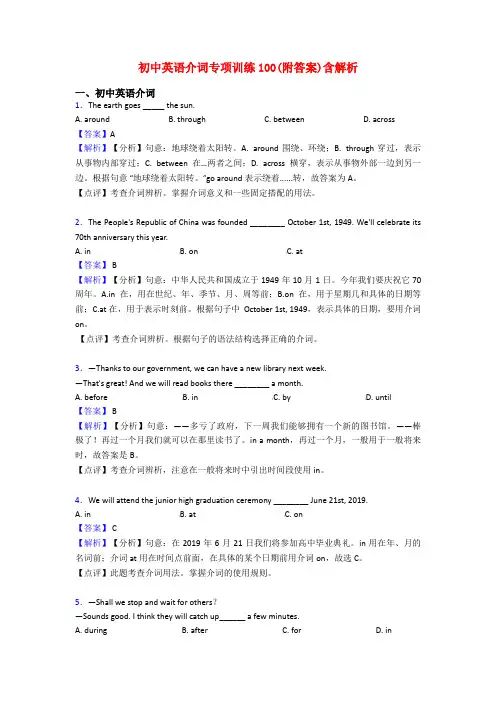
初中英语介词专项训练100(附答案)含解析一、初中英语介词1.The earth goes _____ the sun.A. aroundB. throughC. betweenD. across【答案】A【解析】【分析】句意:地球绕着太阳转。
A. around围绕、环绕;B. through穿过,表示从事物内部穿过;C. between在…两者之间;D. across横穿,表示从事物外部一边到另一边。
根据句意“地球绕着太阳转。
”go around表示绕着......转,故答案为A。
【点评】考查介词辨析。
掌握介词意义和一些固定搭配的用法。
2.The People's Republic of China was founded ________ October 1st, 1949. We'll celebrate its 70th anniversary this year.A. inB. onC. at【答案】 B【解析】【分析】句意:中华人民共和国成立于1949年10月1日。
今年我们要庆祝它70周年。
A.in在,用在世纪、年、季节、月、周等前;B.on在,用于星期几和具体的日期等前;C.at在,用于表示时刻前。
根据句子中 October 1st, 1949,表示具体的日期,要用介词on。
【点评】考查介词辨析。
根据句子的语法结构选择正确的介词。
3.—Thanks to our government, we can have a new library next week.—That's great! And we will read books there ________ a month.A. beforeB. inC. byD. until【答案】 B【解析】【分析】句意:——多亏了政府,下一周我们能够拥有一个新的图书馆。
——棒极了!再过一个月我们就可以在那里读书了。
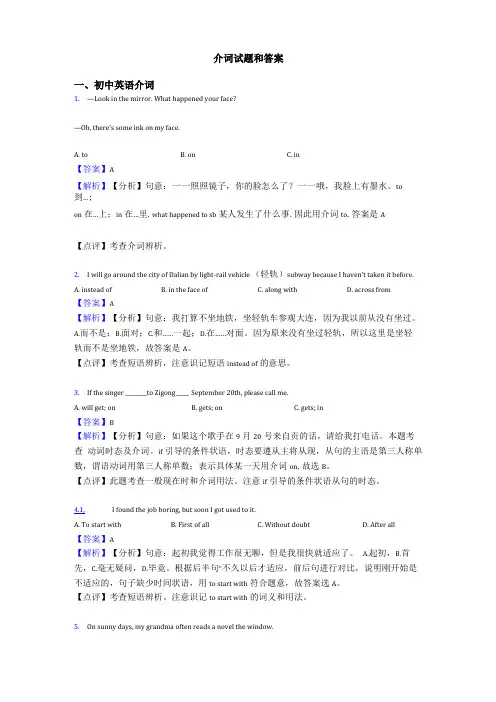
介词试题和答案一、初中英语介词1.—Look in the mirror. What happened your face?—Oh, there's some ink on my face.A. toB. onC. in【答案】A【解析】【分析】句意:一一照照镜子,你的脸怎么了?一一哦,我脸上有墨水。
to 到…;on在…上;in在…里.what happened to sb某人发生了什么事.因此用介词to.答案是A【点评】考查介词辨析。
2.I will go around the city of Dalian by light-rail vehicle (轻轨)subway because I haven't taken it before.A. instead ofB. in the face ofC. along withD. across from【答案】A【解析】【分析】句意:我打算不坐地铁,坐轻轨车参观大连,因为我以前从没有坐过。
A.而不是;B.面对;C.和……一起;D.在……对面。
因为原来没有坐过轻轨,所以这里是坐轻轨而不是坐地铁,故答案是A。
【点评】考查短语辨析,注意识记短语instead of的意思。
3.If the singer ________ t o Zigong _____ September 20th, please call me.A. will get; onB. gets; onC. gets; in【答案】B【解析】【分析】句意:如果这个歌手在9月20号来自贡的话,请给我打电话。
本题考查动词时态及介词。
if引导的条件状语,时态要遵从主将从现,从句的主语是第三人称单数,谓语动词用第三人称单数;表示具体某一天用介词on,故选B。
【点评】此题考查一般现在时和介词用法。
注意if引导的条件状语从句的时态。
4.1,I found the job boring, but soon I got used to it.A. To start withB. First of allC. Without doubtD. After all【答案】A【解析】【分析】句意:起初我觉得工作很无聊,但是我很快就适应了。
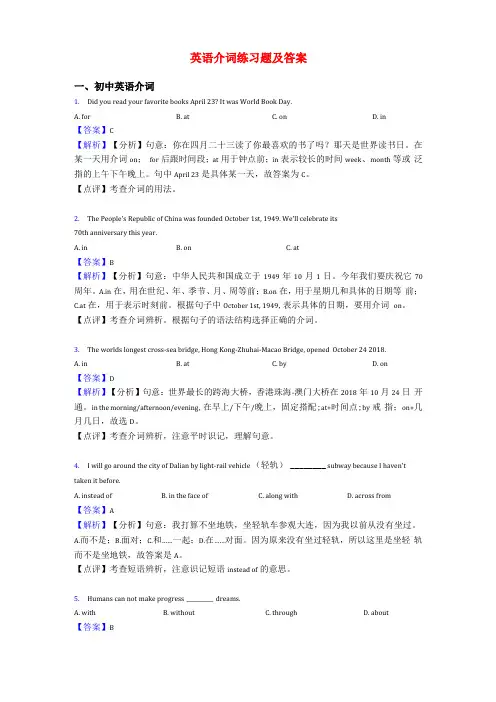
英语介词练习题及答案一、初中英语介词1.Did you read your favorite books April 23? It was World Book Day.A. forB. atC. onD. in【答案】C【解析】【分析】句意:你在四月二十三读了你最喜欢的书了吗?那天是世界读书日。
在某一天用介词on;for后跟时间段;at用于钟点前;in表示较长的时间week、month等或泛指的上午下午晚上。
句中April 23是具体某一天,故答案为C。
【点评】考查介词的用法。
2.The People's Republic of China was founded October 1st, 1949. We'll celebrate its70th anniversary this year.A. inB. onC. at【答案】B【解析】【分析】句意:中华人民共和国成立于1949年10月1日。
今年我们要庆祝它70 周年。
A.in在,用在世纪、年、季节、月、周等前;B.on在,用于星期几和具体的日期等前;C.at在,用于表示时刻前。
根据句子中October 1st, 1949,表示具体的日期,要用介词on。
【点评】考查介词辨析。
根据句子的语法结构选择正确的介词。
3.The worlds longest cross-sea bridge, Hong Kong-Zhuhai-Macao Bridge, opened October 24 2018.A. inB. atC. byD. on【答案】D【解析】【分析】句意:世界最长的跨海大桥,香港珠海-澳门大桥在2018年10月24日开通。
in the morning/afternoon/evening,在早上/下午/晚上,固定搭配;at+时间点;by戒指;on+几月几日,故选D。
【点评】考查介词辨析,注意平时识记,理解句意。
4.I will go around the city of Dalian by light-rail vehicle (轻轨)________ subway because I haven't taken it before.A. instead ofB. in the face ofC. along withD. across from【答案】A【解析】【分析】句意:我打算不坐地铁,坐轻轨车参观大连,因为我以前从没有坐过。
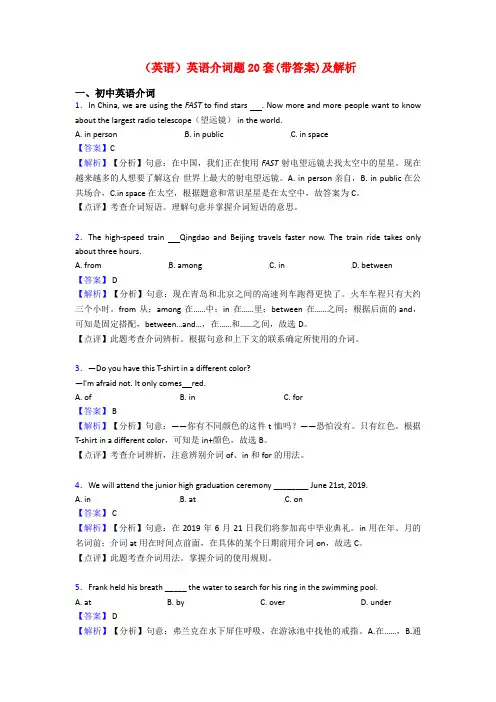
(英语)英语介词题20套(带答案)及解析一、初中英语介词1.In China, we are using the FAST to find stars . Now more and more people want to know about the largest radio telescope(望远镜) in the world.A. in personB. in publicC. in space【答案】C【解析】【分析】句意:在中国,我们正在使用FAST 射电望远镜去找太空中的星星。
现在越来越多的人想要了解这台世界上最大的射电望远镜。
A. in person亲自,B. in public在公共场合,C.in space 在太空,根据题意和常识星星是在太空中,故答案为C。
【点评】考查介词短语。
理解句意并掌握介词短语的意思。
2.The high-speed train Qingdao and Beijing travels faster now. The train ride takes only about three hours.A. fromB. amongC. inD. between【答案】 D【解析】【分析】句意:现在青岛和北京之间的高速列车跑得更快了。
火车车程只有大约三个小时。
from 从;among 在……中;in 在……里;between 在……之间;根据后面的and,可知是固定搭配,between…and…,在……和……之间,故选D。
【点评】此题考查介词辨析。
根据句意和上下文的联系确定所使用的介词。
3.—Do you have this T-shirt in a different color?—I'm afraid not. It only comes red.A. ofB. inC. for【答案】 B【解析】【分析】句意:——你有不同颜色的这件t恤吗?——恐怕没有。
初中英语(完整版)介词专项练习附答案一、选择题1.He was born ________ Feburary, the coldest month of a year in this city.A.on B.in C.at D.over2.My family get together and have a big dinner ________ Sundays.A.at B.in C.on D.to3.—The earthquake in Ya’an took place ________ tw o past eight ________ the morning of April 20th.—Yes, some people were still sleeping for it was weekend.A.in; on B.on; in C.at; in D.at; on4.—Do you really want to refuse this offer?—I have to. I’m afraid the job is ________ my ability.A.beyond B.beside C.behind D.between5.There is a stone bridge ________ the river in front of my house.A.over B.under C.above D.below6.V olunteering is a good way to experience life ________ the campus (校园). Take an active part in it, and you will learn more about the world.A.over B.beyond C.against D.above7.The rain is beating ________ the windows and Cindy is listening to the rain quietly. A.above B.across C.around D.against8.A study shows that rude languages spoken to children may have bad results that go ________ those of beating them.A.against B.beyond C.except D.with9.The grassland, reaching out far away, looks rather beautiful _____ the blue and clean sky. A.against B.above C.through D.past10.I like reading. I often fill my bookshelf ________ all kinds of books, like novels, detective stories, and so on.A.on B.in C.with D.of11.The exercise was __________ the abilities of most students, so very few could work it out. A.beyond B.over C.against D.through 12.Don’t be afraid of difficulties. Remember: kites ris e highest ________ the wind, not with it. A.against B.above C.across D.along13.On sunny days, my grandma often reads a novel ________ the window.A.for B.by C.with D.from 14.Xinjiang cotton is praised ________ the best cotton in the country ________ its high quality. A.for; as B.for; by C.as; for D.by; for15.It’s a pity that the exercise is ________ the abilities of most of the class.A.over B.above C.beyond D.without 16.Some of the technology we’ve seen on screen is ________ our ability to create. But th at might not be true for long.A.against B.during C.beyond D.through17.—I want to visit Liaoning History Museum. Is it open today?—No. It opens every day ________ Monday.A.except B.till C.between D.after18.The chopsticks are ________ wood.A.made of B.made from C.made in D.made with 19.The girl is ________ a singer ________ everyone in her hometown.A.well known as; for B.well-know as; toC.well known as; to D.best known for; for20.Sometimes I feel stressed because what my parents want me to do has gone ________ my ability.A.through B.against C.above D.beyond 21.Because of COVID-19, this summer holiday will begin ________ July 18.A.on B.in C.for D.at22.—Thanks for looking after me ________ my illness, Millie.—Don’t mention it. That’s what friends ar e for.A.beyond B.through C.across D.with23.We have a party ________ the evening of October 31.A.in B.at C.on D.by24.The teacher encouraged the students to tell the story ________ English.A.at B.with C.in D.for25.Anyone who can find the clues ________ the case will get a reward of 5,000 yuan.A.with B.to C.at D.from26.________ a spring morning, a bird flew into our classroom and we were very excited to see it. A.In B.On C.At D.For27.If success is a gate, the road ________ this gate must be full of difficulties.A.beyond B.opposite C.towards D.across28.My family is always ___________ me no matter what I decide to do. That makes me very pleased.A.above B.behind C.against D.through29.— Excuse me, will you please tell me the way to Yangzhou State Guesthouse?— Walk ______ the bridge and go straight on, and you will see it on your left.A.over B.above C.across D.into30.In the end, Mr Song came up____a good method to solve the problem.A.for B.at C.in D.with31.—A serious study of physics is impossible ________ some knowledge of maths.—I couldn’t agree more. So we should also learn maths well.A.among B.between C.against D.without32.If your temperature is_______37.3°, you should go to the doctor instead of going to school. A.above B.against C.under D.below33.Peter is clever enough to read and write __________ the age of 4.A.between B.at C.to D.during34.To our joy, Tom pleased everybody by making his dog walk ________ two legs.A.by B.over C.from D.on35.When are you arriving? I’ll pick you up the station.A.at B.to C.on D.off36.Family is always _________ me, so I can follow my dreams with great courage. A.beyond B.forward C.past D.behind37.— What do you think of those smart kids in the game show?— There is no doubt that many of them have a gift ________ maths.A.for B.in C.on D.at38.To my pleasure, my family is always ________me, so I can follow my dreams with great courage.A.past B.above C.upon D.behind 39.Though there are so many things around us that go ______ our will, we can’t g ive up because following the dream is valuable.A.through B.towards C.against D.beyond40.—I haven’t been to Shenzhen for years.—You really need to pay a visit, and you’ll find changes there are ________ imagination. A.beyond B.through C.without D.for【参考答案】一、选择题1.B解析:B【详解】句意:他在二月出生,这个城市一年中最冷的月份。
(英语)初中英语介词专项训练100(附答案)一、初中英语介词1.More and more people in Qingdao go to work _________subway now.A. withB. onC. inD. by【答案】D【解析】【分析】句意:现在越来越多的青岛人乘地铁去上班。
A. with 用;B. on 在---上;C. in 在---里;D. by乘;根据on/in+the+交通工具,by+交通工具;故选D。
【点评】考查介词辨析。
根据固定搭配选出正确答案。
2.—Is that your headmaster?—You mean the man ________ blue?A. onB. withC. in【答案】 C【解析】【分析】句意:——那是你的校长吗?——你是指穿着蓝色衣服的男士吗?固定搭配,in+颜色,穿着……颜色衣服的人,A 在……上面,B 和……,表伴随,与题意不符,故选C。
【点评】考查介词辨析,注意in+颜色的用法。
3.Yesterday our headmaster made a speech ________ environmental protection, and we learned something about recycling of waste.A. onB. atC. to【答案】 A【解析】【分析】句意:昨天我们的校长做了一个关于环境保护的演讲,并且我们学到了一些关于废物利用的知识。
on,关于,这样与学术有关;at在;to到达。
演讲是关于环境保护的,而环境保护是有关学术的,故选A。
【点评】考查介词辨析,注意平时识记其词义,理解句意。
4.—The Wandering Earth (流浪地球)tells us a story about how people tried to save the earth.—Yes. In the film humans chose to stay with the earth running away from it.A. because ofB. together withC. such asD. instead of【答案】 D【解析】【分析】句意:——流浪地球告诉我们一个有关人类怎样拯救地球的故事。
介词练习题(含答案)经典一、初中英语介词1.— What are you doing?—I'm looking the kids. They should be back for dinner now.A. afterB. atC. forD. up【答案】 C【解析】【分析】句意:——你在做什么?——我正在找孩子们,他们现在应该回来吃晚饭了。
look after 照顾;look at 看……;look for 寻找;look up 查找,一般指查词典。
根据They should be back for dinner now可知,孩子们还没有回来,说话人在找他们。
故选C。
【点评】此题考查短语辨析,注意其意思和用法。
2.The high-speed train Qingdao and Beijing travels faster now. The train ride takes only about three hours.A. fromB. amongC. inD. between【答案】 D【解析】【分析】句意:现在青岛和北京之间的高速列车跑得更快了。
火车车程只有大约三个小时。
from 从;among 在……中;in 在……里;between 在……之间;根据后面的and,可知是固定搭配,between…and…,在……和……之间,故选D。
【点评】此题考查介词辨析。
根据句意和上下文的联系确定所使用的介词。
3.—Do you have this T-shirt in a different color?—I'm afraid not. It only comes red.A. ofB. inC. for【答案】 B【解析】【分析】句意:——你有不同颜色的这件t恤吗?——恐怕没有。
只有红色。
根据T-shirt in a different color,可知是in+颜色,故选B。
【点评】考查介词辨析,注意辨别介词of、in和for 的用法。
英语)英语介词练习题含答案一、初中英语介词1.— Who is the space scientist from Beijing?—The man ____ white over there. He's of medium height.A. withB. inC. orD. for【答案】 B【解析】【分析】句意 :—谁是来自北京的太空科学家 ?—在那边穿白色衣服的那个人。
他中等身材。
in+颜色词 ,表示“穿着某某颜色的衣服”习,惯用法。
故选B。
【点评】考查介词辨析题。
牢记此结构。
2. The People's Republic of China was founded October 1st, 1949. We'll celebrate its70th anniversary this year.A. in B . on C . at【答案】 B【解析】【分析】句意:中华人民共和国成立于 1949 年 10 月 1 日。
今年我们要庆祝它 70 周年。
A.in 在,用在世纪、年、季节、月、周等前; B.on 在,用于星期几和具体的日期等前; C.at在,用于表示时刻前。
根据句子中October 1st, 1949 ,表示具体的日期,要用介词 on。
【点评】考查介词辨析。
根据句子的语法结构选择正确的介词。
3.— Is that your headmaster?—You mean the man ____ blue?A. on B . with C . in【答案】 C【解析】【分析】句意:——那是你的校长吗?——你是指穿着蓝色衣服的男士吗?固定搭配, in+颜色,穿着⋯⋯颜色衣服的人, A 在⋯⋯上面, B 和⋯⋯,表伴随,与题意不符,故选 C。
【点评】考查介词辨析,注意in+颜色的用法。
4., I found the job boring, but soon I got used to it.A. To start withB. First of allC. Without doubtD. After all 【答案】 A【解析】【分析】句意:起初我觉得工作很无聊,但是我很快就适应了。
(英语)初中英语介词试题(有答案和解析)含解析一、初中英语介词1.I stopped _____the night in a small village while I was on holiday in the Himalayas a few years ago.A. atB. forC. untilD. through【答案】 B【解析】【分析】意思:很多年前当我在喜马拉雅山脉度假的时候,我在一个小村镇停留了一个晚上。
stop for the night停下来过夜,故答案为B.【点评】考查介词辨析,掌握固定搭配。
2.John often takes a walk _______ his grandpa after dinner.A. toB. forC. alongD. with【答案】 D【解析】【分析】句意:约翰经常晚饭后和他的爷爷散步。
A.朝;B.为了;C.沿着;D.和……一起。
根据his grandpa,可知此处应是晚饭后跟爷爷散步,故选D。
【点评】考查介词辨析。
注意句子涉及到with的词义和用法。
3.My mother often says, "Stand tall like the sunflower and be proud who you are." A. of B. with C. at D. in【答案】 A【解析】【分析】句意:我妈妈经常说,像向日葵一样挺起胸膛,为自己感到骄傲。
be proud of,固定搭配,为……骄傲,故选A。
【点评】考查固定搭配,注意be proud of的用法。
4.If the singer to Zigong September 20th, please call me.A. will get; onB. gets; onC. gets; in【答案】 B【解析】【分析】句意:如果这个歌手在9月20号来自贡的话,请给我打电话。
(英语)英语介词题20套(带答案)及解析一、初中英语介词1.The earth goes _____ the sun.A. aroundB. throughC. betweenD. across【答案】A【解析】【分析】句意:地球绕着太阳转。
A. around围绕、环绕;B. through穿过,表示从事物内部穿过;C. between在…两者之间;D. across横穿,表示从事物外部一边到另一边。
根据句意“地球绕着太阳转。
”go around表示绕着......转,故答案为A。
【点评】考查介词辨析。
掌握介词意义和一些固定搭配的用法。
2.We communicate _____ each other in many ways, such as by e-mail or by phone.A. onB. throughC. inD. with【答案】 D【解析】【分析】句意:我们用很多方法相互联系,比如通过电子邮件或者电话。
communicate with,与某人联系,与某人保持联系,固定搭配,故答案是D。
【点评】考查介词辨析,注意识记固定搭配communicate with的用法。
3.Frank held his breath _____ the water to search for his ring in the swimming pool.A. atB. byC. overD. under【答案】 D【解析】【分析】句意:弗兰克在水下屏住呼吸,在游泳池中找他的戒指。
A.在……,B.通过某种方式;C.高于;D.在……下,面。
根据Frank held his breath 和in the swimming,可知一定是在水下,应使用介词under,故答案是D。
【点评】考查介词辨析,注意结合语境思考问题并解决问题。
4.Ben was helping his mother when the rain began to beat heavily ________the windows.A. againstB. acrossC. aboveD. below【答案】 A【解析】【分析】句意:Ben正在帮他妈妈的忙,这时雨开始猛烈地打在窗户上。